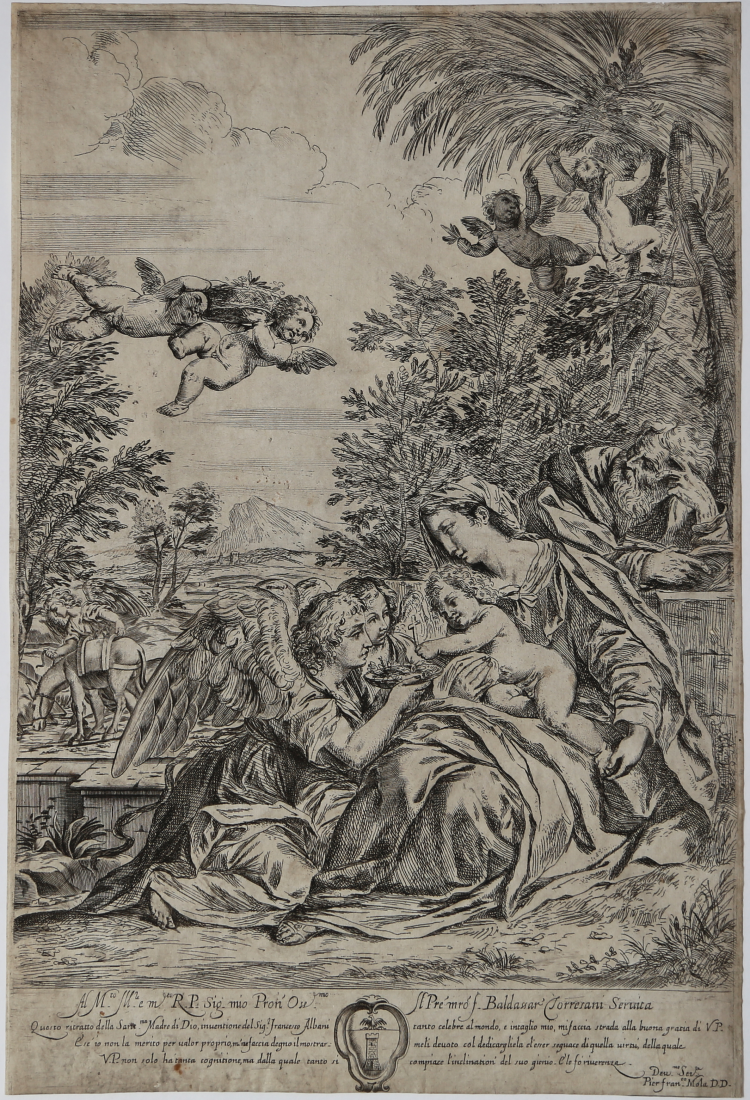



| Reference: | S37021 |
| Author | Pier Francesco MOLA |
| Year: | 1640 ca. |
| Measures: | 315 x 472 mm |


| Reference: | S37021 |
| Author | Pier Francesco MOLA |
| Year: | 1640 ca. |
| Measures: | 315 x 472 mm |
Engraving and etching, 1640 circa, inscribed with dedication and signed: ' Al M.to Ill.e e m.to R. P. Sig. mio Pron Oss.mo // Il P. re mro f. Baldassa Torresani Seruita [...] Pier fran.co Mola D.D.'
Good example, printed on contemporary laid paper, trimmed close to platemark, occasional foxing, generally in good condition.
After a painting by Francesco Albani last documented in the Yarborough Collection, Brocklesby Park.
According to Bartsch, the angel leading the donkey was engraved later by an anonymous artist.
|
Bartsch XIX.204.4; D'Amico and Bellini 1978, no. 16
|
Pier Francesco MOLA (Como 1612 - Roma 1666)
|
Painter and draughtsman, son of Giovanni Battista Mola. His most characteristic works are small, intensely romantic scenes from mythology, the Bible, and from works by the poet Torquato Tasso, set in landscapes inspired by Venetian art. Yet he also received important public commissions for frescoes and altarpieces, and in his mature work he achieved an impressive synthesis of 17th-century Roman gran maniera painting with the stronger chiaroscuro and richer palette of the 16th-century Venetian style. He was a prolific and versatile draughtsman, who drew for pleasure as well as in preparation for commissions; he was also a witty caricaturist, who mocked himself and his friends as much as more typical targets, such as clerics and art patrons.
|
|
Bartsch XIX.204.4; D'Amico and Bellini 1978, no. 16
|
Pier Francesco MOLA (Como 1612 - Roma 1666)
|
Painter and draughtsman, son of Giovanni Battista Mola. His most characteristic works are small, intensely romantic scenes from mythology, the Bible, and from works by the poet Torquato Tasso, set in landscapes inspired by Venetian art. Yet he also received important public commissions for frescoes and altarpieces, and in his mature work he achieved an impressive synthesis of 17th-century Roman gran maniera painting with the stronger chiaroscuro and richer palette of the 16th-century Venetian style. He was a prolific and versatile draughtsman, who drew for pleasure as well as in preparation for commissions; he was also a witty caricaturist, who mocked himself and his friends as much as more typical targets, such as clerics and art patrons.
|